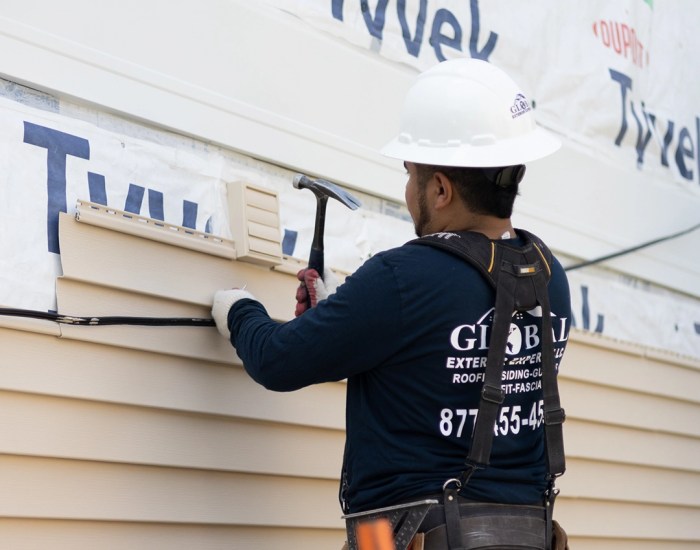Embark on a journey through the world of global siding and roofing, where we delve into the latest trends, materials, and sustainable practices shaping the industry. Discover how advancements in technology have revolutionized this sector, impacting both aesthetics and functionality.
Introduction to Global Siding and Roofing
Global siding and roofing refer to the materials and techniques used in the construction and renovation of exterior walls and roofs on a worldwide scale. These components are crucial for protecting buildings from environmental elements, enhancing energy efficiency, and improving aesthetics.Advancements in technology have revolutionized the global siding and roofing industry, leading to the development of innovative materials with enhanced durability, sustainability, and performance.
These technological breakthroughs have enabled manufacturers to offer a wide range of options to meet the diverse needs of consumers across the globe.
Significance of Global Trends in Siding and Roofing Materials
Global trends in siding and roofing materials play a vital role in shaping the construction industry by influencing design choices, construction practices, and environmental impact. The demand for eco-friendly and energy-efficient materials has driven the development of sustainable solutions that reduce the carbon footprint of buildings.
- Increasing focus on sustainability: Global trends in siding and roofing materials emphasize the use of sustainable resources, such as recycled materials, natural fibers, and energy-efficient designs.
- Enhanced durability and performance: Technological advancements have led to the creation of high-performance materials that offer superior protection against harsh weather conditions, UV radiation, and wear and tear.
- Aesthetic appeal and customization: Consumers are increasingly seeking siding and roofing materials that not only provide functional benefits but also enhance the visual appeal of their properties. Global trends in design and customization cater to these preferences.
Impact of Technological Advancements on the Global Siding and Roofing Industry
Technology has transformed the global siding and roofing industry by enabling manufacturers to improve product quality, streamline production processes, and enhance installation techniques. The integration of digital tools, automation, and data analytics has revolutionized the way materials are developed, marketed, and installed.
Industry 4.0 technologies, such as 3D modeling, virtual reality, and drone imaging, have enabled professionals to visualize projects, optimize designs, and monitor construction progress with greater precision and efficiency.
- Smart solutions for energy efficiency: Technological innovations have paved the way for the development of smart siding and roofing systems that can regulate temperature, manage moisture, and reduce energy consumption in buildings.
- Enhanced safety and sustainability: Advanced materials and construction techniques supported by technology have improved the safety standards and environmental sustainability of siding and roofing projects worldwide.
Types of Siding Materials
When it comes to siding materials, there are several options available globally, each with its own unique characteristics and benefits. Let's explore some of the popular siding materials used in the construction industry.
Vinyl Siding
- Vinyl siding is one of the most commonly used siding materials due to its affordability and low maintenance requirements.
- It is durable, resistant to rot and insect damage, and comes in a variety of colors and styles.
Fiber Cement Siding
- Fiber cement siding is a versatile and durable option that can mimic the look of wood, stucco, or masonry.
- It is resistant to fire, rot, and pests, making it a popular choice for homeowners looking for a long-lasting siding material.
Wood Siding
- Wood siding provides a natural and traditional look to a home, adding warmth and character to the exterior.
- While wood siding requires more maintenance compared to other materials, it can be a sustainable and eco-friendly option when sourced from responsibly managed forests.
Composite Siding
- Composite siding is a blend of wood fibers and recycled plastics, offering the natural look of wood with the durability of plastic.
- It is low maintenance, resistant to moisture and insects, and comes in a variety of colors and textures.
Innovative Eco-Friendly Siding Materials
- Sustainable siding materials like recycled metal or reclaimed wood are gaining popularity for their environmentally friendly properties.
- Additionally, bio-based siding materials made from plant fibers or agricultural by-products are emerging as innovative and sustainable alternatives in the market.
Roofing Systems Around the World
Roofing systems vary greatly across different regions globally, influenced by factors such as climate, culture, and available resources. Let's explore some traditional roofing systems, the impact of climate on the choice of roofing materials, and the evolution of modern roofing systems to meet global standards.
Traditional Roofing Systems
In regions like Japan, traditional roofing materials such as ceramic tiles have been used for centuries due to their durability and ability to withstand earthquakes. In the Middle East, flat roofs made of materials like mud and straw have been adapted to combat the intense heat.
These traditional systems reflect the local climate conditions and cultural preferences.
Impact of Climate on Roofing Materials
The choice of roofing materials is heavily influenced by the climate of a region. In hot climates, materials like clay tiles and metal roofs are popular for their heat-reflecting properties. In colder regions, materials like slate and asphalt shingles are preferred for their insulating abilities.
Climate considerations play a crucial role in determining the longevity and efficiency of a roofing system.
Evolution of Modern Roofing Systems
Modern roofing systems have evolved to incorporate advanced materials and technologies to meet global standards of efficiency and sustainability. Green roofs, which involve planting vegetation on the roof surface, have gained popularity for their environmental benefits. Additionally, innovations in solar roofing systems have allowed for the integration of renewable energy sources into the roof structure, enhancing energy efficiency.
Sustainability and Energy Efficiency

In response to growing environmental concerns, the global siding and roofing industries are increasingly focusing on adopting sustainable practices. This includes utilizing eco-friendly materials, implementing energy-efficient solutions, and obtaining green building certifications.
Adoption of Sustainable Practices
- Many companies are now offering siding materials made from recycled content, such as reclaimed wood or recycled plastic.
- Roofing manufacturers are developing products that are durable, long-lasting, and energy-efficient to reduce the need for frequent replacements.
- Green roofs, which involve planting vegetation on rooftops, are becoming more popular for their energy-saving benefits and aesthetic appeal.
Importance of Energy-Efficient Roofing Solutions
- Energy-efficient roofing solutions help reduce heating and cooling costs by providing better insulation and reducing heat transfer.
- Cool roofs, which reflect more sunlight and absorb less heat, can help lower indoor temperatures and reduce the urban heat island effect.
- Solar panels integrated into roofing systems can generate renewable energy and further reduce reliance on non-renewable resources.
Green Building Certifications
- LEED (Leadership in Energy and Environmental Design) certification recognizes buildings that meet high standards of sustainability and energy efficiency, including the materials used for siding and roofing.
- ENERGY STAR certification identifies products that meet strict energy efficiency guidelines set by the Environmental Protection Agency (EPA), promoting the use of eco-friendly roofing materials.
- Passive House certification focuses on creating ultra-energy-efficient buildings that require minimal heating or cooling, often achieved through advanced siding and roofing solutions.
Final Summary
As we conclude our exploration of global siding and roofing, it becomes evident that the industry is evolving to meet the demands of a changing world. From traditional materials to eco-friendly innovations, the future looks promising for sustainable and energy-efficient solutions in construction.
FAQ Summary
What are the most popular eco-friendly siding materials?
Common eco-friendly siding materials include reclaimed wood, fiber cement, and recycled metal, known for their sustainability and durability.
How does climate influence the choice of roofing materials?
Climate plays a crucial role in selecting roofing materials, with factors like temperature, precipitation, and wind affecting durability and performance.
Are there specific certifications for green siding and roofing materials?
Yes, certifications like LEED (Leadership in Energy and Environmental Design) and Energy Star are often associated with green building practices in the construction industry.






